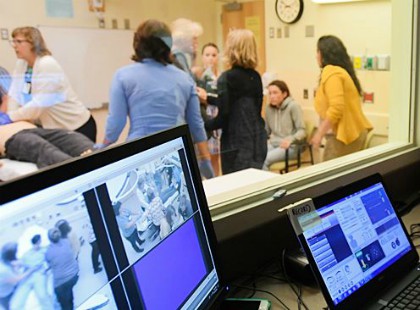In the fall of 2019, more than 400 students from different health science professions came together over the course of three evening sessions to care for a dying patient—virtually. Medical and nursing students, physical therapy doctoral candidates, social workers-in-training, speech pathology trainees and pharmacy students from the Albany College of Pharmacy watched standardized patients on screen as they played the roles of a patient with amyotrophic lateral sclerosis, family members, and health care providers.

In the fall of 2019, more than 400 students from different health science professions came together over the course of three evening sessions to care for a dying patient—virtually. Medical and nursing students, physical therapy doctoral candidates, social workers-in-training, speech pathology trainees and pharmacy students from the Albany College of Pharmacy watched standardized patients on screen as they played the roles of a patient with amyotrophic lateral sclerosis, family members, and health care providers. The students, seated in small groups, discussed what they witnessed in the video. They talked about emotions the scene evoked, where communication broke down, where the team excelled, and how they’d work together in a similar situation.
The workshop—led by Mary Val Palumbo, D.N.P, APRN, director of interprofessional education (IPE) at the UVM College of Nursing and Health Sciences—is just one example of the future of IPE at the University of Vermont. As the needs of patients become increasingly complex, teams that span the health professions are critical to delivering high quality patient care. The trend nationally is towards more integration: In 2009, six national associations of schools of health professions formed the Interprofessional Education Collaborative to prepare future health professionals for team-based care focused on prevention and population health. Revised key competencies published in 2016 have become the gold standard for the field.
One faculty member who is moving the needle forward at UVM: Interprofessional Education Visiting Scholar Nancy LeMieux, MSN, RN, CHSE, a clinical instructor in the UVM College of Nursing and Health Sciences. She will serve in this position, supported by the Larner College of Medicine’s Teaching Academy and the UVM College of Nursing and Health Sciences, until July of 2020. She’s tasked with advancing IPE through faculty development and student learning activities, as well as tracking existing IPE curricula and providing support and coaching to faculty who are designing activities. It’s important that faculty and students learn “about, from and with” each other as they engage in the work. The overlap with the Larner College of Medicine’s emphasis on active learning provides additional opportunity.
“This is fertile ground for first developing foundational communication and teamwork skills and understanding the roles and responsibilities of other health care professionals,” she says. “Later in curricula, students in clinical settings collaborate to bring the unique contributions of each profession to the care of patients. Our ultimate goal is to prepare health professions students for interprofessional collaborative practice when they enter the workforce.”
One state of the art tool is the UVM Clinical Simulation Laboratory (CSL), which has been a hub of IPE since its opening in 2011. Two-day CSL workshops that introduce faculty to the power of simulation as a tool for IPE have led to many fruitful collaborations. Cate Nicholas, Ed.D., M.S., P.A., director of education and operations for the CSL and assistant professor of obstetrics, gynecology and reproductive sciences, says the space lends itself to stepping outside of your comfort zone.
“A simulation experience is neutral ground,” she says. “Learners start to identify where some of their synergies lie.” The annual Cultural Awareness Conference has been a mainstay of IPE for 18 years. Originally founded as an event for family medicine residents, attendees now include first-year medical students, advanced practice nursing students, dental students, family medicine residents, and pharmacy students from the Albany College of Pharmacy and Health Sciences, with support from the Office of Primary Care, Office of Diversity and Inclusion, the Department of Nursing, the Department of Family Medicine, and the Albany College of Pharmacy. In 2019, the half-day conference focused on opioid use disorder, while past topics have included human trafficking, adverse childhood experiences, and wealth and poverty in Vermont. The conference is designed to foster dialogue and collaboration, says Martha Seagrave, PA-C, associate professor and director of medical student education programs for the Department of Family Medicine.
In the fall of 2019, the CNHS Interprofessional Education Steering Committee will host the third annual “Introduction to IPE and Collaborative Care” event for students from programs including athletic training, physical therapy, counseling, medicine, pharmacy, nursing, and others. Small group activities keep the focus on students learning from each other, says Seagrave, laying the groundwork for a team-based approach throughout their careers.
“Evidence shows that when teams work well together and are more collaborative, then patients do better,” Seagrave says. “Team members are happier as well, which leads to better outcomes.